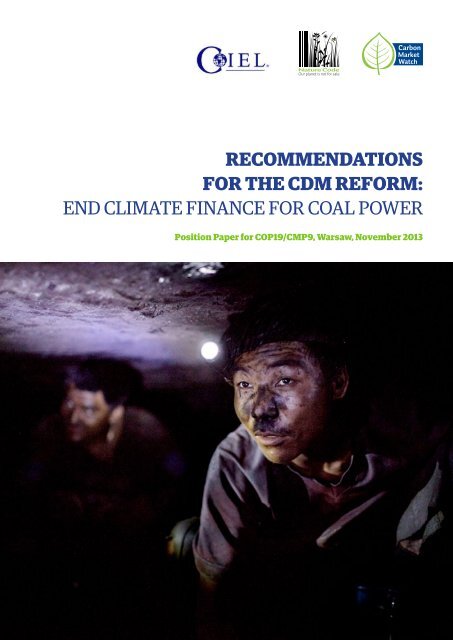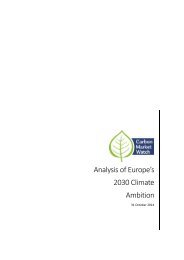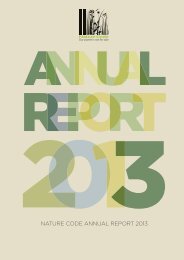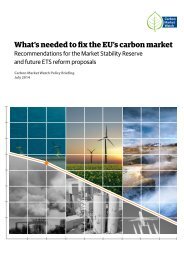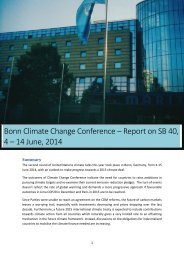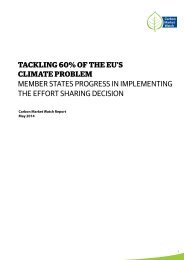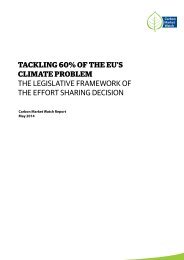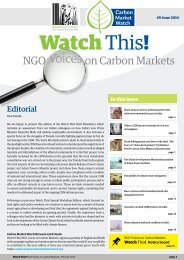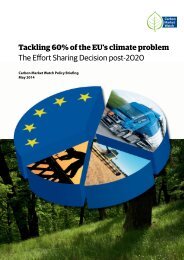RECOMMENDATIONS FOR THE CDM REFORM: END CLIMATE FINANCE FOR COAL POWER
Create successful ePaper yourself
Turn your PDF publications into a flip-book with our unique Google optimized e-Paper software.
<strong>RECOMM<strong>END</strong>ATIONS</strong><br />
<strong>FOR</strong> <strong>THE</strong> <strong>CDM</strong> RE<strong>FOR</strong>M:<br />
<strong>END</strong> <strong>CLIMATE</strong> <strong>FINANCE</strong> <strong>FOR</strong> <strong>COAL</strong> <strong>POWER</strong><br />
Position Paper for COP19/CMP9, Warsaw, November 2013
EXECUTIVE SUMMARY<br />
The Clean Development Mechanism (<strong>CDM</strong>) was designed<br />
to bring clean and sustainable development to poor countries<br />
while enabling rich countries to achieve their emissions<br />
reductions cost effectively.<br />
Yet, the <strong>CDM</strong> allows new coal plants to earn tradable emissions<br />
credits for claimed improvements in power plant efficiency.<br />
This is unacceptable because:<br />
> Carbon Market Watch calls on Parties to exclude<br />
coal power plants from the <strong>CDM</strong> with immediate<br />
effect.<br />
• New coal power plants, no matter how efficient,<br />
undermine climate mitigation goals by locking in<br />
millions of tons of CO2 emissions over decades to<br />
come.<br />
• Coal’s overall human and ecological toll is<br />
staggering.<br />
• These projects are not additional because new<br />
coal power plants are built to be efficient to<br />
minimize fuel costs, regardless of <strong>CDM</strong> support.<br />
Such offsets therefore lead to a net increase in<br />
global GHG emissions<br />
<strong>COAL</strong> AND <strong>CLIMATE</strong> CHANGE<br />
<strong>COAL</strong> FACTS<br />
New coal power plants undermine climate mitigation<br />
goals by locking in millions of tons of CO2 emissions for<br />
decades to come. Coal power plants generate about 40%<br />
of all electricity worldwide and are responsible for over 8<br />
giga tons of CO2 emissions. Without additional measures<br />
and with electricity demand worldwide projected to be<br />
double, emissions from coal will grow to over 18 Giga<br />
tonnes of CO2 by 2030 . Yet, if we want to prevent severe,<br />
potentially catastrophic effects from climate change we<br />
need to act quickly and dramatically reduce greenhouse<br />
gas (GHG) emissions. We can only achieve such drastic<br />
emissions reductions by rapidly phasing out the use of<br />
coal.<br />
• 1 kWh electricity from coal produces about 1kg<br />
of CO2.<br />
• Over 40% of world electricity is generated from<br />
coal.<br />
• Total coal combustion causes over 12 Giga tons<br />
of CO2 emissions per year, two thirds of that<br />
comes from to electricity production.<br />
• Coal accounts for about 25% of all global<br />
greenhouse gas emissions.<br />
(Source: IEA 2010)<br />
To put things in perspective: Annual emissions from the<br />
coal plants currently in the <strong>CDM</strong> pipeline are likely to<br />
exceed the current annual CO2 emissions of Australia (399<br />
mio t), France (376 mio t) or Brazil (390 mio t).<br />
New coal power plants compromise the ability of countries<br />
to follow a low carbon development path. Developing<br />
countries urgently need new energy infrastructure to<br />
support livelihoods and economic growth. Low or zerocarbon<br />
alternatives are readily available, including<br />
renewable power, and energy efficiency.
<strong>COAL</strong>’S TRUE ECOLOGICAL AND HUMAN HEALTH COSTS<br />
Coal projects hardly represent a ‘clean technology’ and<br />
have no place in a mechanism that aims to protect the<br />
climate and help the poor develop in a safe and sustainable<br />
way.<br />
Coal’s overall human and ecological toll is staggering.<br />
In 2012 pollution from coal - fired power plants caused<br />
100,000 premature deaths in India. In China, more<br />
than 31,000 coal miners died from accidents from<br />
2000 – 2006. In addition, the total cost of coal use on<br />
Chinese society has been estimated at more than 7%<br />
of GDP (1.7 trillion yuan per year) when the costs of air<br />
and water pollution, ecosystem degradation, damage to<br />
infrastructure, human injuries and loss of life are included.<br />
Similarly, a recent study of coal impacts in the US<br />
estimated that if the environmental and health damages<br />
were fully accounted for, the price of electricity from coal<br />
would double or triple.<br />
<strong>COAL</strong> PROJECTS IN <strong>THE</strong> <strong>CDM</strong><br />
The coal projects in the <strong>CDM</strong> pipeline have a truly a<br />
staggering climate impact. To date, six coal power projects<br />
located in India and China have been registered by the<br />
<strong>CDM</strong> Executive Board. These projects could generate more<br />
than 7 million offset credits annually and will emit almost<br />
10 times the amount of CO2 they claim to save.<br />
But this is only the beginning. More than 40 other coal<br />
projects are trying to get registered. These coal plants<br />
are expected to emit well over 4 billion tonnes of CO2 by<br />
2020. In addition, if registered, these coal power projects<br />
could generate more than 500 million <strong>CDM</strong> offset credits<br />
from now until 2020.<br />
The Sasan power project @Bank Information Centre / Joe Athialy<br />
<strong>CDM</strong> <strong>COAL</strong> PROJECTS INCREASE GLOBAL EMISSIONS<br />
<strong>CDM</strong> project developers apply to receive offset credits by<br />
claiming that they would build a less efficient new coal<br />
plant if they did not receive <strong>CDM</strong> offset.<br />
However, studies show that new coal power plants are<br />
built to be efficient to minimize fuel costs, regardless of<br />
<strong>CDM</strong> support. Research commissioned by the <strong>CDM</strong> Policy<br />
Dialogue furthermore showed that all large-scale power<br />
projects, including coal projects, are unlikely to be additional.<br />
Offset credits from such projects therefore do not represent<br />
real emissions reductions and result in an increase in<br />
global emissions if used against climate commitments. Nevertheless<br />
all large power projects, except nuclear remain<br />
eligible in the <strong>CDM</strong>.<br />
RECOMM<strong>END</strong>ATION<br />
Coal is the world’s most carbon intensive fossil fuel and<br />
its negative environmental and human health impacts are<br />
staggering. Ongoing <strong>CDM</strong> support for coal could lavish billions<br />
of Euros on an already grossly profitable fossil fuel<br />
industry at a time when the world desperately needs to<br />
dedicate scarce climate finance towards renewable energy<br />
and energy efficiency.<br />
But coal power is just the tip of the iceberg of a much larger<br />
integrity problem in the <strong>CDM</strong>. Research estimates that<br />
the <strong>CDM</strong> has likely delivered only 40% of the emission reductions<br />
it sold as offsets. This is primarily because the<br />
<strong>CDM</strong> hosts so many large scale power projects which are<br />
highly unlikely to be additional.<br />
Major investment banks, including the World Bank, have<br />
started to eliminate or limit funding of new coal power<br />
plants. Following the recent announcements of the Norwegian<br />
and the British government to stop endorsing investments<br />
in <strong>CDM</strong> coal projects, eyes are now set on the COP-<br />
19 in Warsaw to see whether the UNFCCC will follow this<br />
trend and kick coal power out of the <strong>CDM</strong>.<br />
> Policy makers need to act now and excluded coal<br />
power from the <strong>CDM</strong>.<br />
> Moreover, all large-scale power projects must be<br />
removed from the <strong>CDM</strong>
About Carbon Market Watch<br />
Carbon Market Watch is a project of<br />
Nature Code – Centre of Development<br />
& Environment. For more information<br />
about Nature Code, see www.<br />
naturecode.org. Carbon Market<br />
Watch scrutinises carbon markets and<br />
advocates for fair and effective climate<br />
protection.<br />
About Center for International<br />
Environmental Law (CIEL)<br />
CIEL uses the power of law to protect the<br />
environment, promote human rights, and ensure<br />
a just and sustainable society. CIEL is a nonprofit<br />
organization dedicated to advocacy in the<br />
global public interest, including through legal<br />
counsel, policy research, analysis, education,<br />
training and capacity building.<br />
Eva Filzmoser, Director<br />
eva.filzmoser@carbonmarketwatch.org<br />
www.carbonmarketwatch.org<br />
Alyssa Johl, Senior Attorney, Climate & Energy Program<br />
ajohl@ciel.org<br />
Center for International Environmental Law<br />
http://www.ciel.org/<br />
i. International Energy Agency, 2010. Key World Energy Statistics<br />
ii. International Energy Agency, 2010. CO2 Emissions From Fuel Combustion. Highlights.<br />
iii. Coal Kills, An Assessment of Death and Disease caused by India’s Dirtiest Energy Source. http://www.greenpeace.org/india/Global/india/report/Coal_<br />
Kills.pdf<br />
iv. Mao Yushi, Sheng Hong, Yang Fuqiang. 2008. The true cost of coal.<br />
v. Paul R. Epstein, Jonathan J. Buonocore, Kevin Eckerle, Michael Hendryx, Benjamin M. Stout III, Richard Heinberg, Richard W. Clapp, Beverly May,<br />
Nancy L. Reinhart, Melissa M. Ahern, Samir K. Doshi, and Leslie Glustrom (2011). Full cost accounting for the life cycle of coal in “Ecological Economics<br />
Reviews.” Robert Costanza, Karin Limburg & Ida Kubiszewski, Eds. Ann. N.Y. Acad. Sci. 1219: 73–98.<br />
vi. A policy brief by the Stockholm Environment Institute summarises the significant environmental integrity concerns of large-scale power projects . See<br />
SEI policy brief “Transitioning Away from Large-Scale Power Projects: A Simple and Effective Fix for the <strong>CDM</strong>? “, 2012<br />
vii. Assessing the Impact of the <strong>CDM</strong>. Report Commissioned By The High-Level Panel On The Cdm Policy Dialogue. July 2012.<br />
viii. http://www.cdmpolicydialogue.org/research/1030_impact.pdf<br />
ix. Estimated emissions reductions based on PDDs = 438 million, CER price = Eur 8, Estimated CER revenue: Eur 3.5 billion<br />
x. Assessing the Impact of the <strong>CDM</strong>. Report Commissioned By The High-Level Panel On The Cdm Policy Dialogue. July 2012.<br />
xi. http://www.cdmpolicydialogue.org/research/1030_impact.pdf


